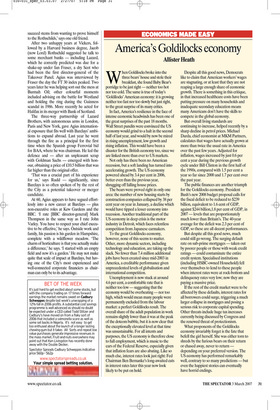America’s Goldilocks economy
Allister Heath
When Goldilocks broke into the three bears’ house and stole their breakfast, she found Baby Bear’s porridge to be just right — neither too hot nor too cold. The same is true of today’s ‘Goldilocks’ American economy: it is growing neither too fast nor too slowly but just right, to the great surprise of its many critics.
In fact, America’s resilience in the face of intense economic headwinds has been one of the great surprises of the past 18 months. Wall Street pundits were convinced the US economy would grind to a halt in the second half of last year, and would by now be mired in rising unemployment, low growth and rising inflation. This would have been a disaster for the British economy too, since we are linked more than ever to US markets.
Not only has there been no American recession, but a soft landing has turned into accelerating growth. The US economy powered ahead by 3.4 per cent in 2006, better even than the previous year, shrugging off falling house prices.
The bears were proved right in only one area: the number of new housing starts by construction companies collapsed by 38 per cent year on year in January, a decline which would have tipped a lesser economy into recession. Another traditional part of the US economy in deep crisis is the motor industry in Detroit, which faces relentless competition from Japanese carmakers.
To the great Goldilocks economy, however, none of this seems to matter. Other, more dynamic sectors, including technology and education, are taking up the slack. No fewer than 7.4 million additional jobs have been created since mid-2003 in America, a creditable performance given unprecedented levels of globalisation and international competition.
Unemployment is now stuck at around 4.6 per cent, a comfortable rate that is neither too low — suggesting that the economy would be overheating — nor too high, which would mean many people were permanently excluded from the labour market: a perfect Goldilocks result. The overall share of the adult population in work remains slightly lower than it was at the peak of the dotcom bubble, but it is now clear that the exceptionally elevated level at that time was unsustainable. For all intents and purposes, the US economy is therefore close to full employment, which is music to the ears of the Federal Reserve, especially given that inflation fears are also abating. Like so much else, interest rates look just right: Fed Chairman Ben Bernanke’s long-awaited cuts in interest rates later this year now look likely to be put on hold. Despite all this good news, Democrats like to claim that American workers’ wages are stagnating, or at least that they are not reaping a large enough share of economic growth. There is something in this critique, in that increased healthcare costs have been putting pressure on many households and inadequate secondary education means many Americans don’t have the skills to compete in the global economy.
But overall living standards are continuing to increase, helped recently by a sharp decline in petrol prices. Michael Darda, chief economist at MKM Partners, calculates that wages have actually grown at more than twice the usual rate in America over the past few years. Adjusted for inflation, wages increased by just 0.6 per cent a year during the previous growth cycle under Bill Clinton in the first half of the 1990s, compared with 1.5 per cent a year so far since 2000 and 1.7 per cent over the past year.
The public finances are another triumph for the Goldilocks economy. President Bush’s new 2008 budget proposal calls for the fiscal deficit to be reduced to $239 billion, equivalent to 1.6 cent of GDP, against $244 billion,1.8 per cent of GDP, in 2007 — levels that are proportionately much lower than Britain’s. The 40-year average for the deficit was 2.3 per cent of GDP, so these are all decent performances.
But despite all this good news, much could still go wrong. The surging default rate on sub-prime mortgages — taken out by poorer people or those with weak credit ratings — could contaminate the entire credit system. Specialised institutions (including HSBC-owned Household) fell over themselves to lend to these people when interest rates were at rock-bottom and delinquency rates very low; now they are paying a massive price.
If the rest of the credit market were to be affected by these defaults, interest rates for all borrowers could surge, triggering a much larger collapse in mortgages and posing a serious risk to corporate capital spending. Other threats include huge tax increases currently being discussed by Congress and the renewed threat of protectionism.
What proponents of the Goldilocks economy invariably forget is the fate that befell the girl herself. She was either torn to shreds by the furious bears on their return or chased away, never to return depending on your preferred version. The US economy has performed remarkably well, contrary to so many predictions — but even the happiest stories can eventually have horrid endings.










































































 Previous page
Previous page